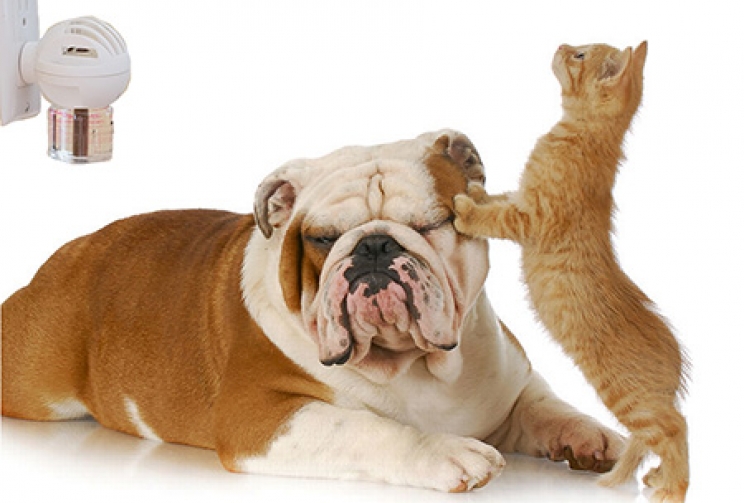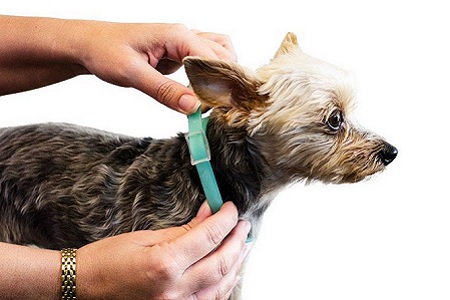Most of the behavioural problems of our animals can find a valid solution thanks to the use of synthetic pheromones. What are pheromones? How are these products used in dogs and cats?
What are they
Synthetic pheromones are nothing more than copies of the pheromones that are produced by our animals. These are chemicals that have the task of communicating a specific message to other animals of the same species.
Both the dog and the cat, in fact, like many other species of animals, are able to produce a large number of pheromones, thanks to the presence of specific glands, located in several parts of the body.
These glands are found mainly around the animal's face, in the ears, between the fingertips, in the area of the anus and genitals and even in the breasts.
Each of these glands is capable of producing a different type of pheromone, which "hides" a specific message. In fact, there are several categories of pheromones, which can be grouped:
- Sex pheromones: they have a dual function. On the one hand, they are used to communicate messages for reproductive purposes (females release this pheromone to communicate its availability for mating). At the same time, they can also be produced to attract sexual partners and to recognize hierarchies among multiple animals;
- Emotional pheromones: they are used to modulate the animal's emotions, for example to induce relaxation when he feels too agitated;
- Territorial pheromones: we find them mainly in the genital, perianal glands and between the fingertips. They are released to mark the territory, especially in the presence of other animals. Not surprisingly, one of the main functions of cat scratching is precisely to signal its presence to other cats;
- Social pheromones: they stimulate socialization with other animals and group recognition;
- Alarm pheromones: they are used to signal the presence of a danger to other animals. The typical example is the vet's table. When a dog or cat is placed on the table, it is easy to notice persistent footprints, which do not come off easily, precisely because they will have to communicate the dangerous situation to the animals that will be visited later;
- Fulfilment pheromones: released by the mother to stimulate bonding with the offspring.
Among these types of pheromones, the synthetic ones recreated in the laboratory and used to make environmental diffusers and sprays for cats are the fractions F3 and F4, which are used respectively for the neutralization of fear and for socialization purposes. In dogs, on the other hand, apaisin is contained, an analogue of the contentment pheromones produced by the mother.
How do they work
Synthetic pheromones can be used to alleviate and solve a large number of behavioral problems in our animals. The most important are:
- Scratching: cats can scratch furniture and upholstery to mark the territory;
- Urinary markings: both the dog and the cat, when they are stressed or feel threatened by the presence of other animals, can begin to urinate in the most inappropriate places or, as in the case of male cats, to "spray" traces of urine on the walls;
- Stress, anxiety and phobias: these problems can represent real discomfort for the animal, with important consequences for both the mind and the body;
- Relocations: a move, a trip or a short visit to the veterinarian can put a strain on the animal's emotional resistance, which can feel confused or frightened;
- Presence of other animals: dogs and cats are territorial animals. When they can no longer perceive their own smell as the predominant one in the house, they can feel threatened. For this reason, the arrival of other animals in the house can trigger territorial reactions such as aggression or frustration;
- Arrival of guests or children: some animals just cannot accept the arrival of new people to disrupt their daily rhythms and their spaces, so they can react aggressively or by hiding;
- Adoption of a kitten or puppy: the newcomer will have to face both the separation from his mother and the introduction into an unknown environment;
- Catteries and kennels: forced coexistence with other animals can often create serious emotional distress in dogs and cats, with problems such as anxiety, stress or depression.

By using products which contain synthetic pheromones, it is possible to recreate an environment for the animal that is compatible with its emotional and territorial needs.
Synthetic pheromones, in fact, replace those normally produced by animals, so they manage to interfere with the altered communication of messages.
To give an example, if you were to adopt a new cat, thanks to the use of synthetic pheromones you will be able to deceive our "old" friend, making him believe that he still has full control over the marking of the territory. Otherwise, we may find ourselves with the wallpaper completely destroyed and two cats perpetually fighting each other.
Synthetic pheromones can also be used to introduce a kitten or new puppy into the home. Thanks to the presence of contentment pheromones, it will be possible to reduce the sense of loss associated with the detachment from one's mother, while at the same time stimulating attachment to the new owners and the new environment.
How to use them
Synthetic pheromones are readily available commercially both in the form of room diffusers, sprays and dog collars.
The synthetic pheromone diffuser is simply plugged into a power outlet, possibly in the room where the animal spends most of its time. It must be left there 24 hours a day, without ever detaching it, because its effectiveness increases over time.
Diffusers need at least 2-3 days to start making an effect, so if you have to use them to introduce a new pet into your home, you should activate them a few days before their arrival.
The spray, on the other hand, is particularly indicated above all to prevent behavioural manifestations related to transport and all situations outside the home, such as a visit to the vet or encounters with other animals in the park. It can be sprayed in the car or in the pet carrier, at least 15 minutes before taking off.
The synthetic pheromone-based dog collar, on the other hand, is excellent both indoors and outdoors, and is able to release a constant dose of pheromones throughout the day.
Synthetic pheromones have no contraindications and can be used for animals of all ages. In case of coexistence between dogs and cats, it will be necessary to resort to two types of synthetic pheromones, one for dogs and one for cats, because these substances are species-specific, i.e. they are recognized only by animals of the same species as those who produced them.


